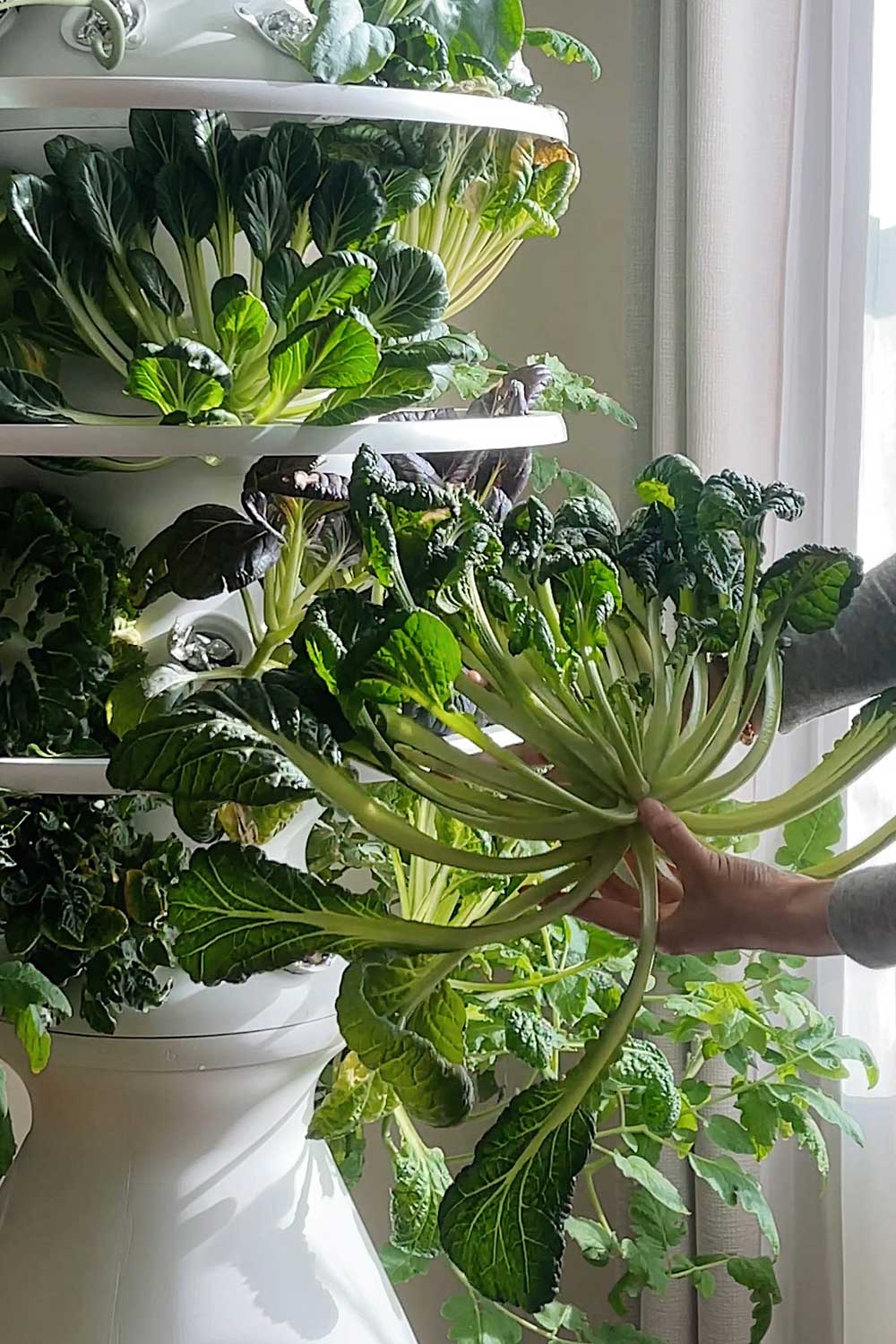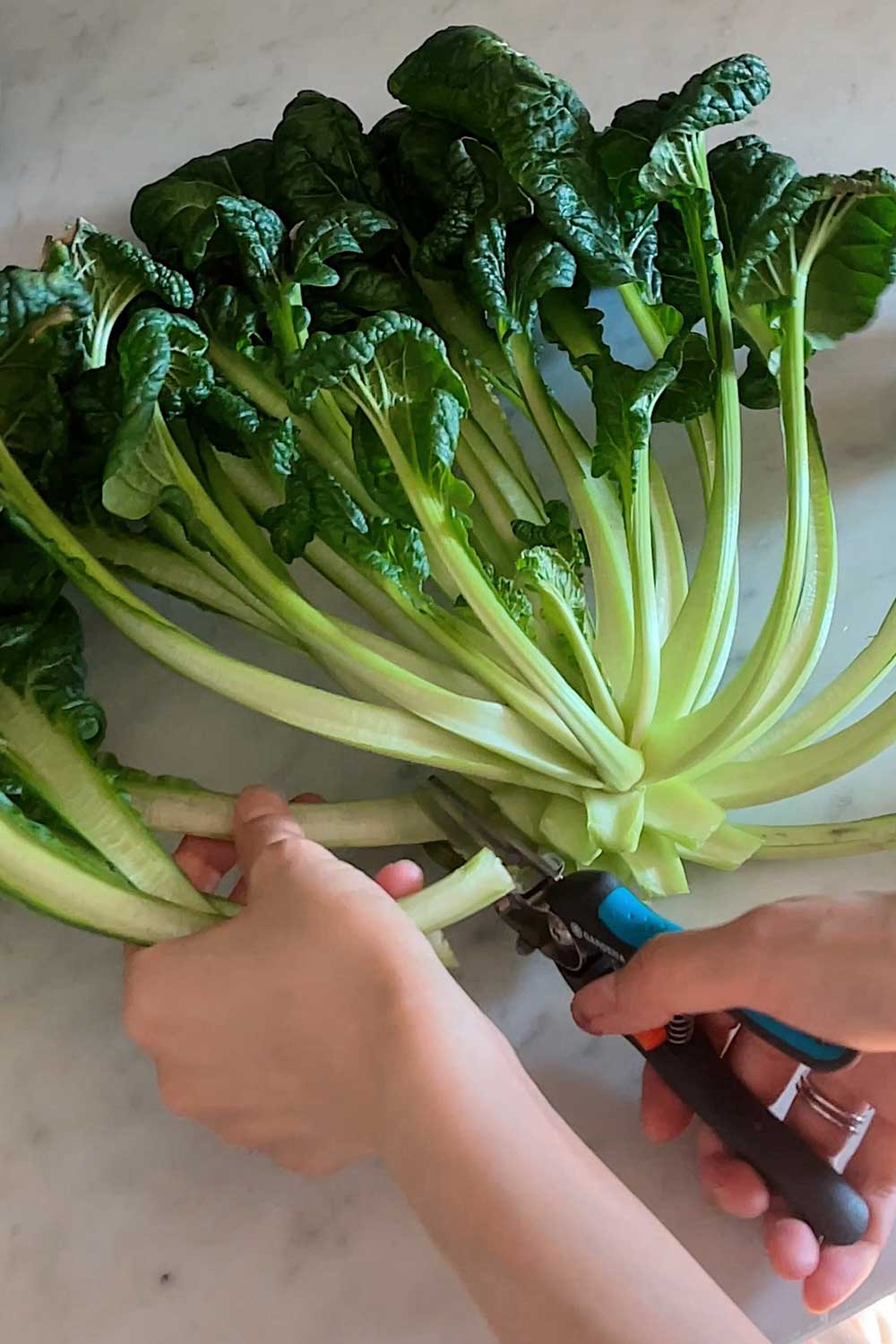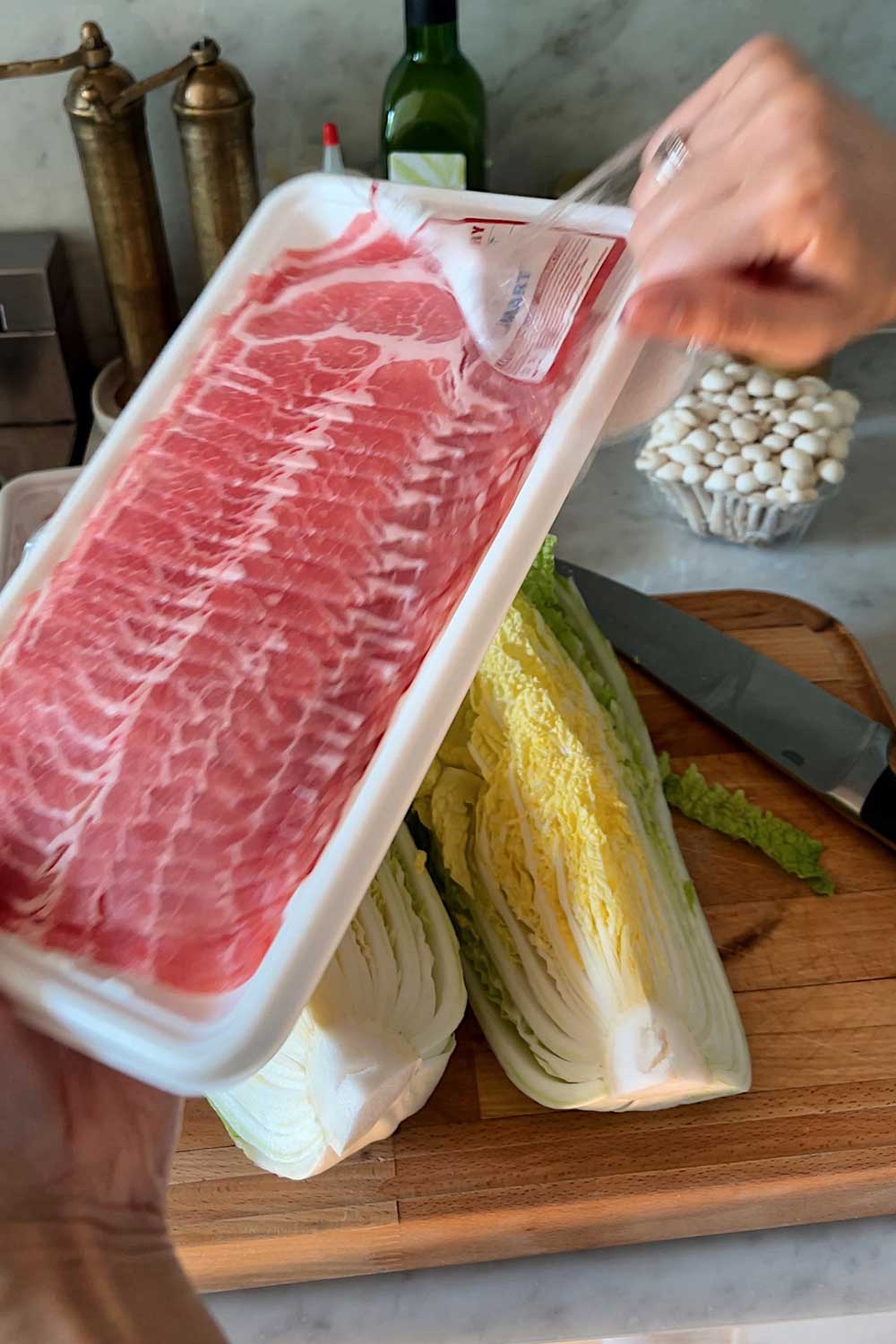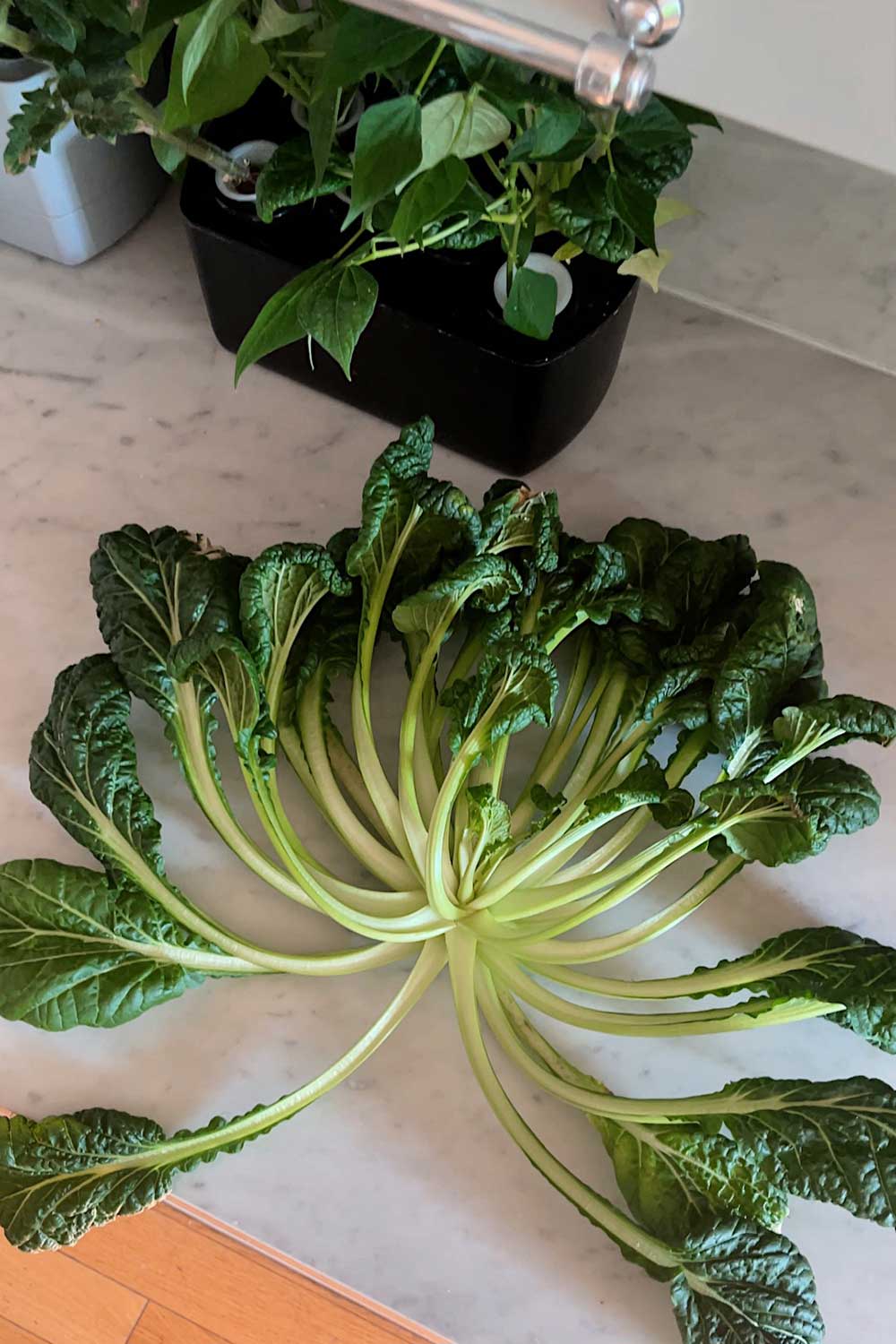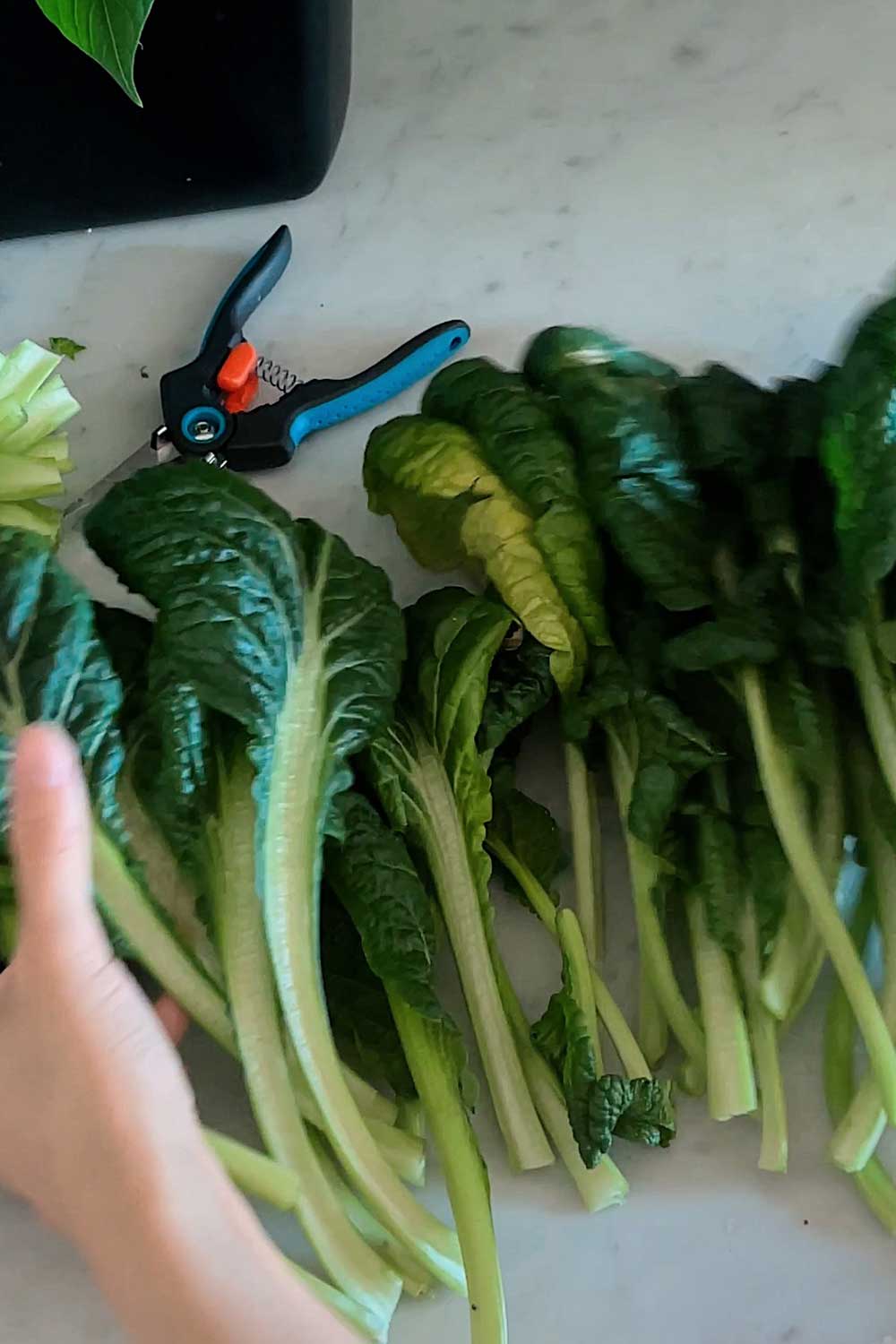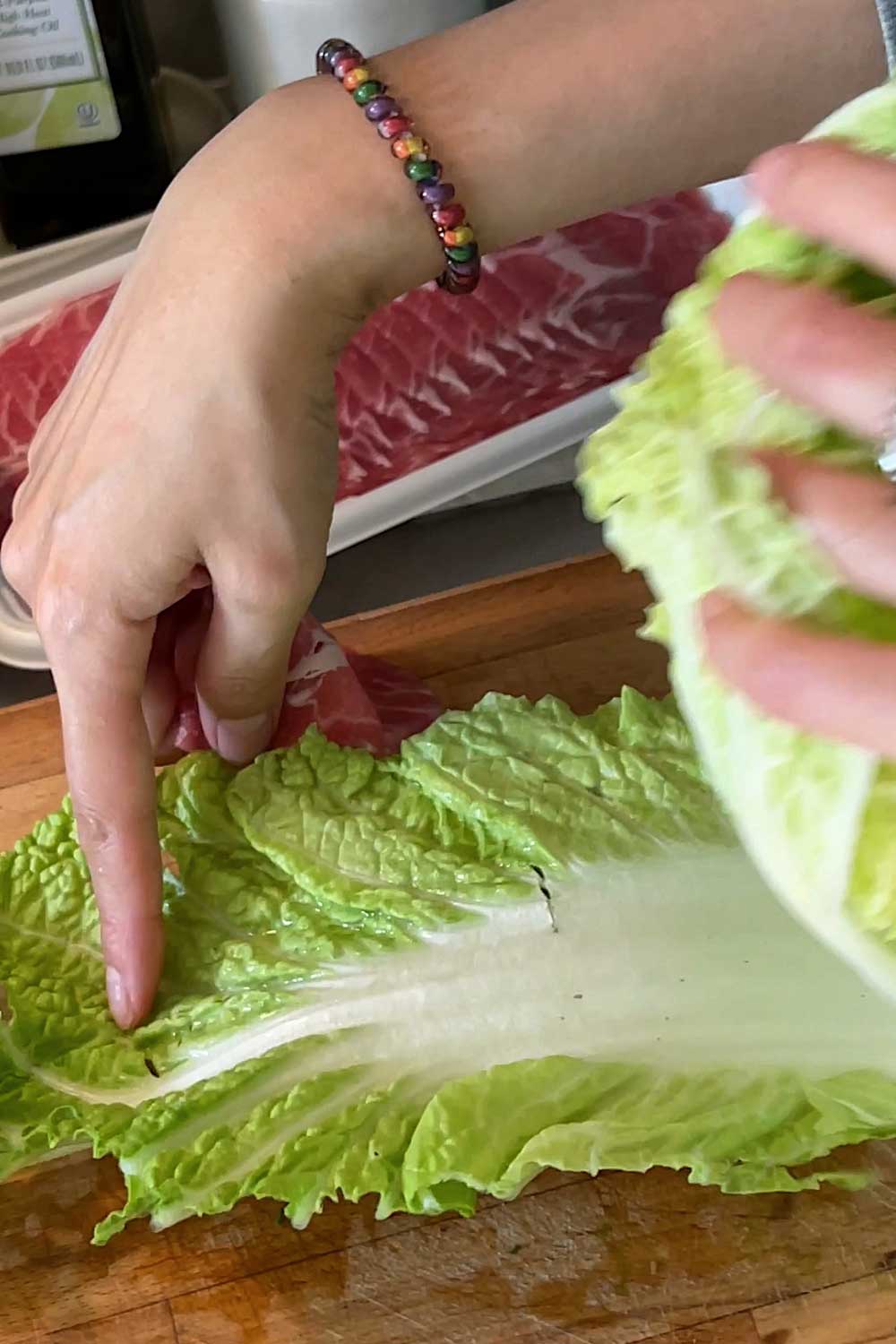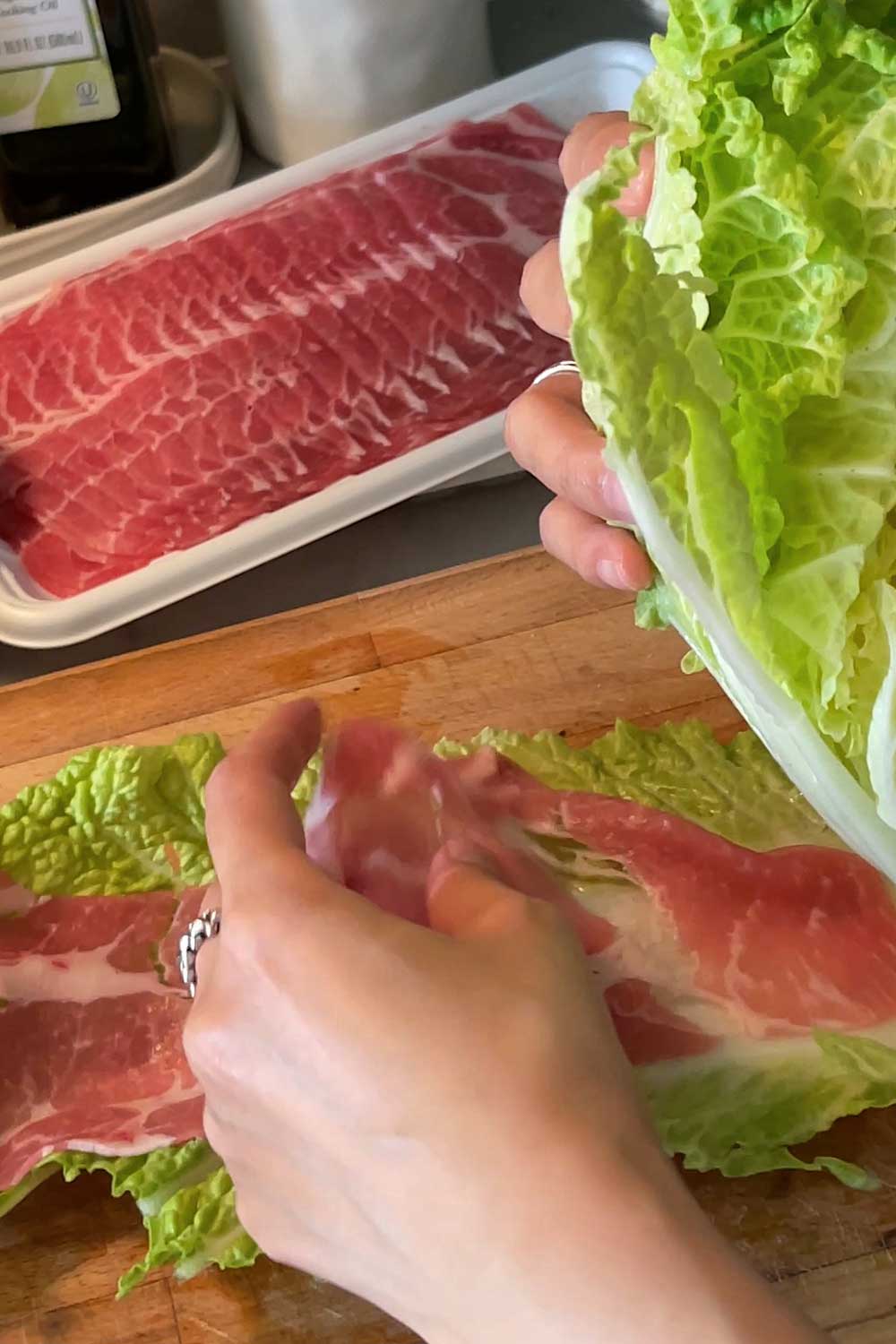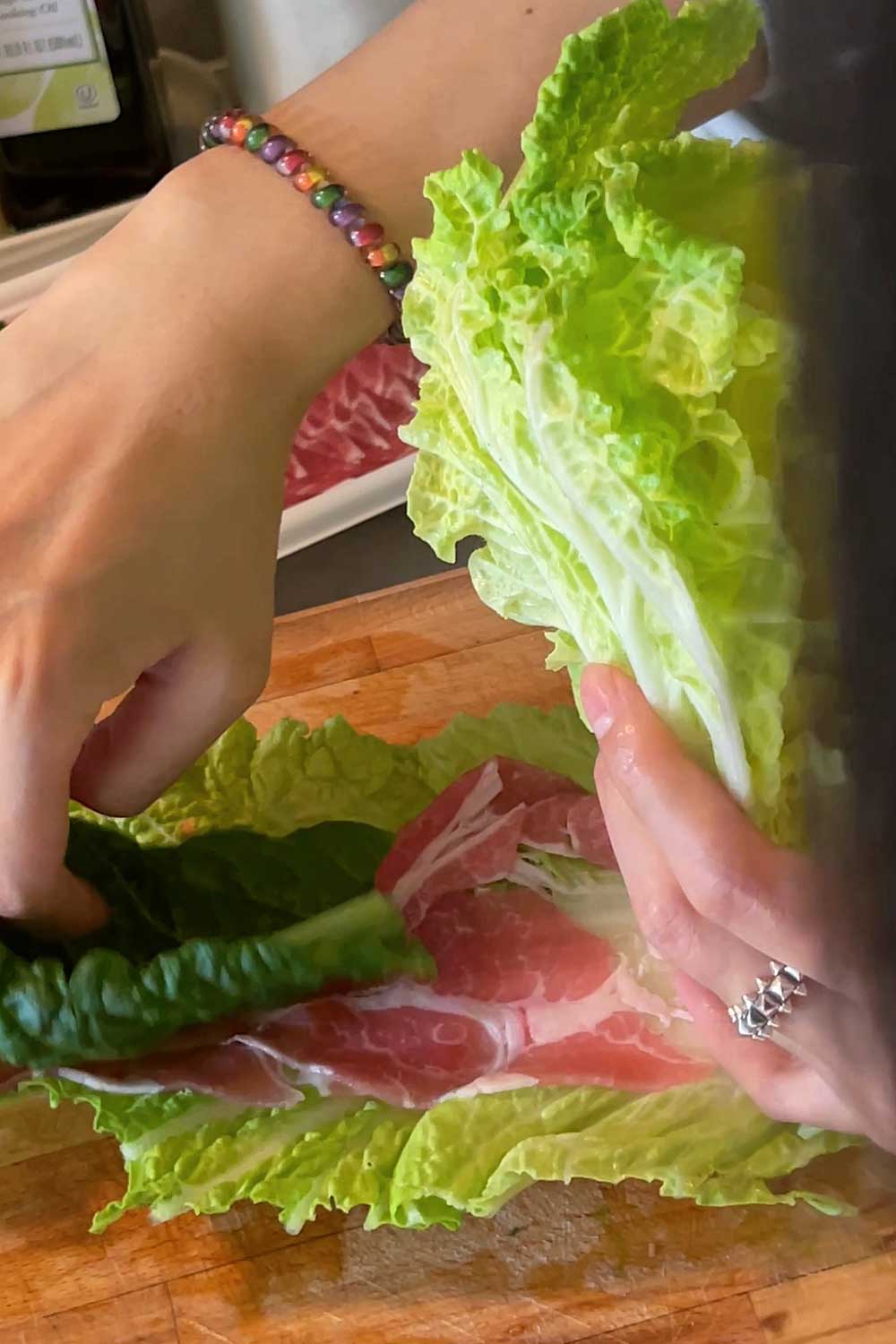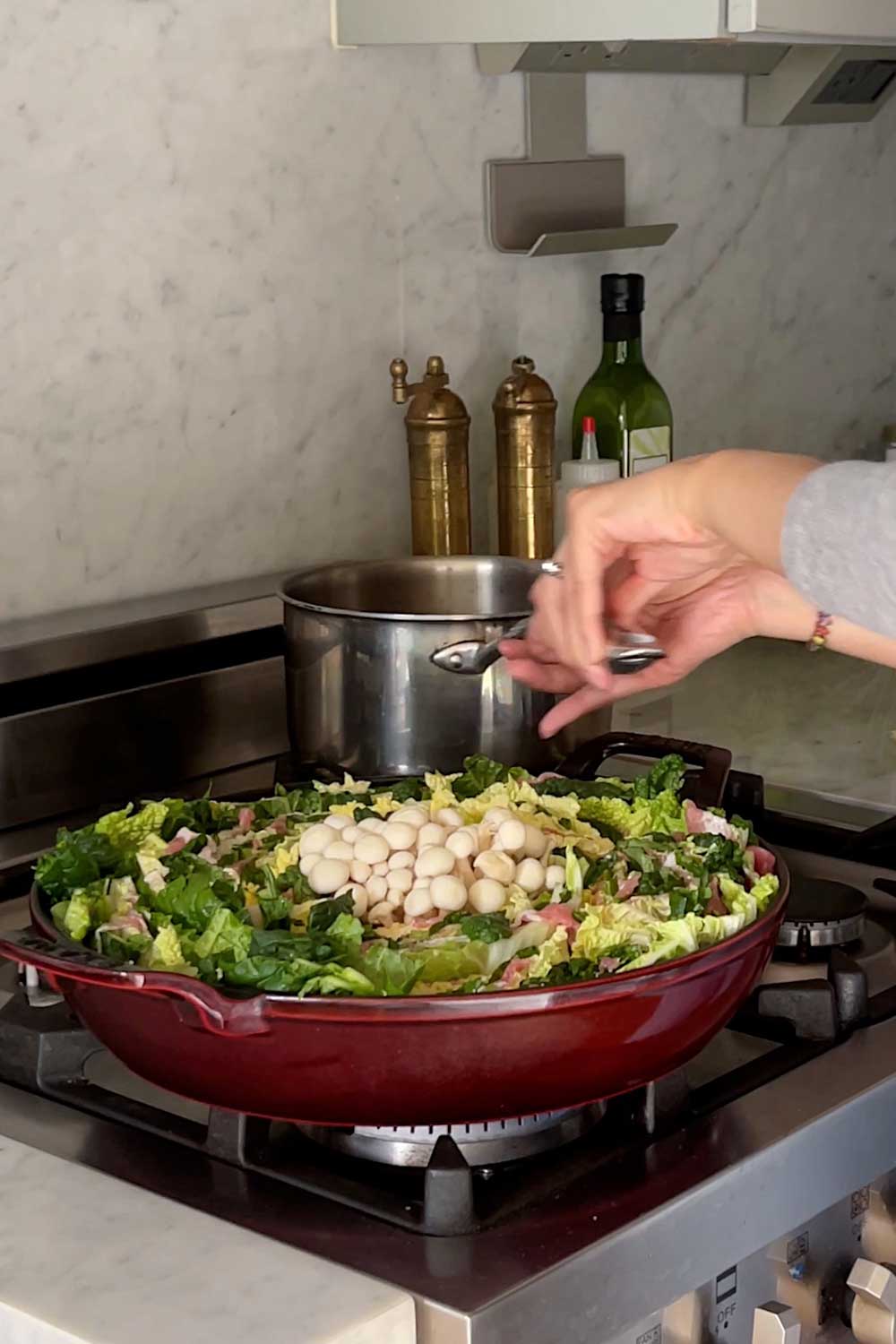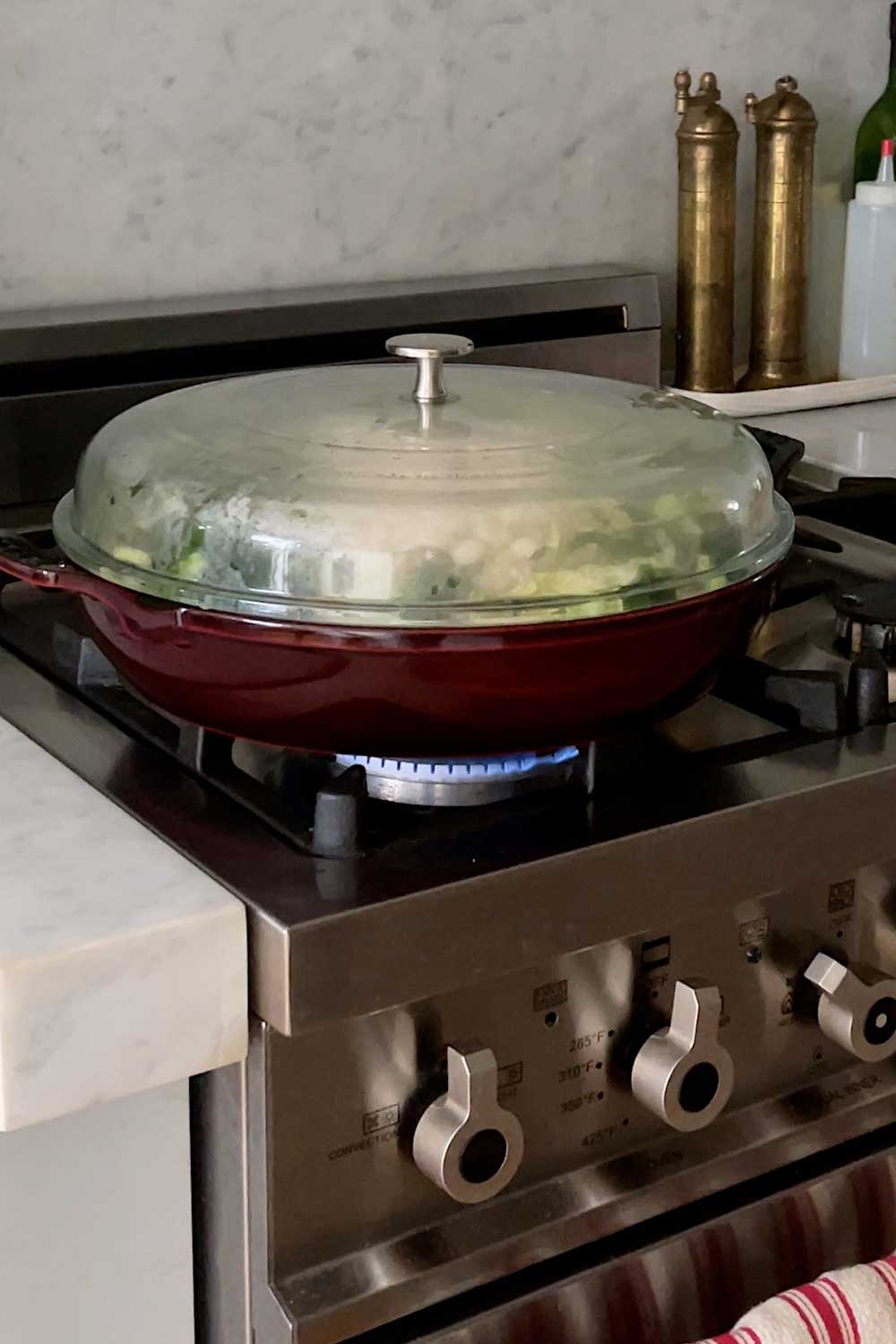A light and simple hot pot meal at home!
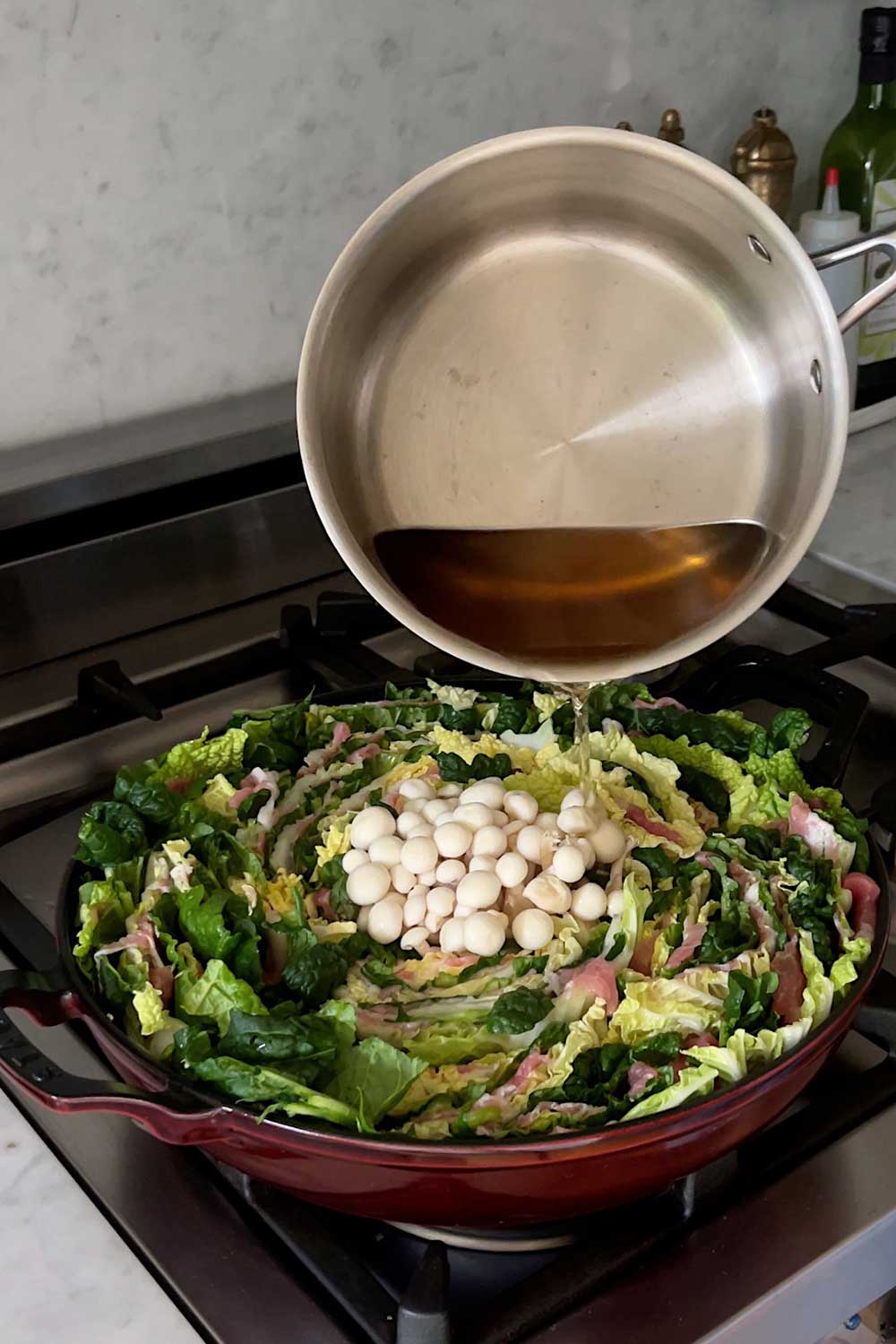
As soon as the days get shorter and the temperatures drop, my friends and I love to get hotpot.
We typically trek all the way out to Flushing, Queens for the best hotpot in the city, but sometimes it’s nice to have a simple easy version at home.
For that, I make mille feuille nabe.
It’s a Japanese hotpot dish, that’s much lighter and ‘cleaner’ tasting than Chinese style hotpot.
It also uses less ingredients and is much easier to make at home!
Alternating sections of napa cabbage and pork belly are packed together in a pot to form a pretty ‘thousand layer’ look, then slowly simmered in a broth of savory dashi.
It’s super light, comforting and warm – the perfect meal for winter nights at home.
Mille Feuille Nabe Video Recipe
Cabbage
Traditional mille feuille nabe calls for napa cabbage and pork belly.
The amount of cabbage you’ll need depends on the size of your pot.
For 3-4 people, I like this 3.5 quart cast iron braiser. It needs half a head of a large cabbage.
For 1-2 people, I like this 2 quart small cast iron pot. It needs a quarter of a medium cabbage.
It’s important to tightly pack the layers in the pot.
Cabbage releases a lot of water as it cooks, so if your pan is too big for your layers, the pretty rosette shape will shrink and lose its form in the finished dish!
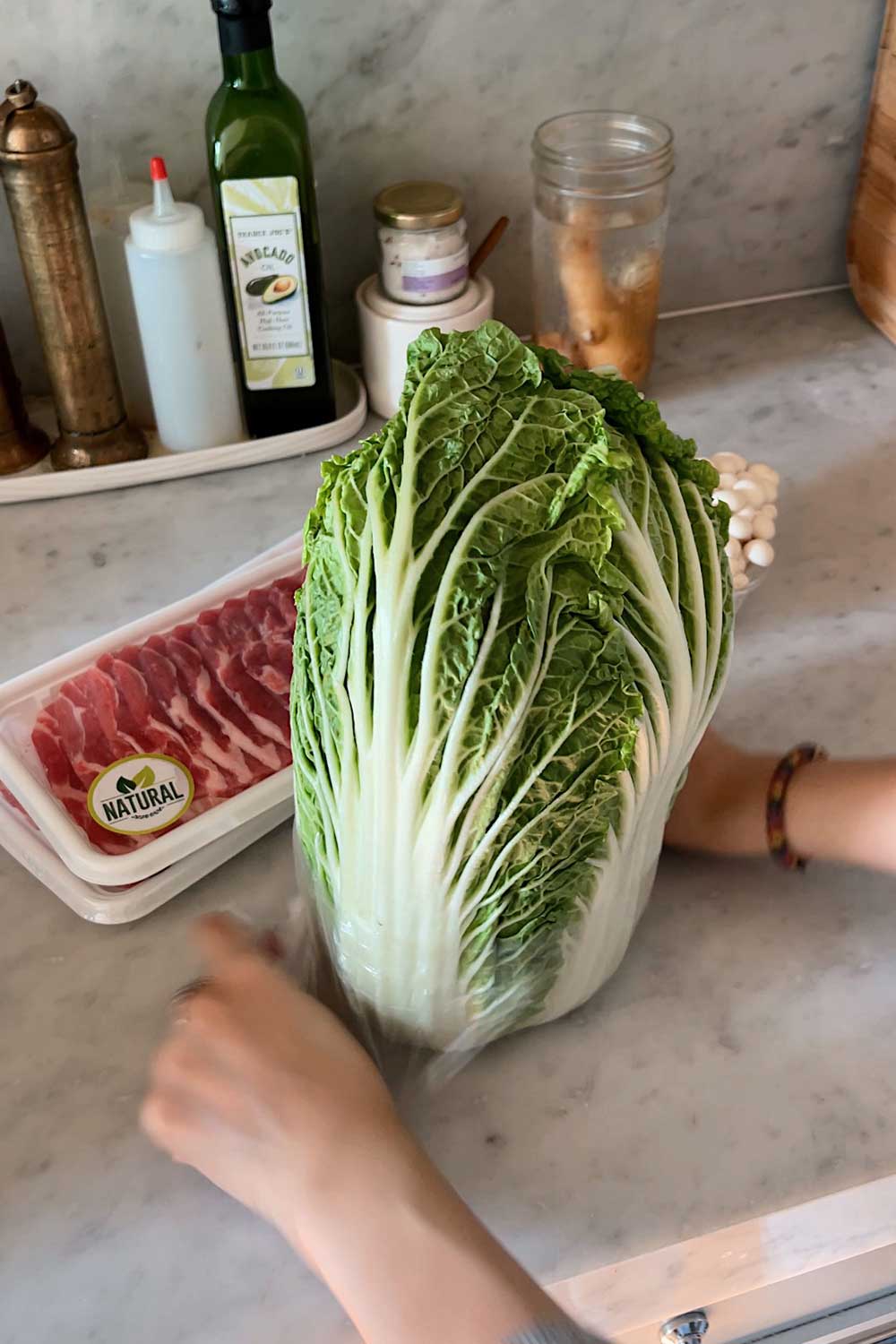
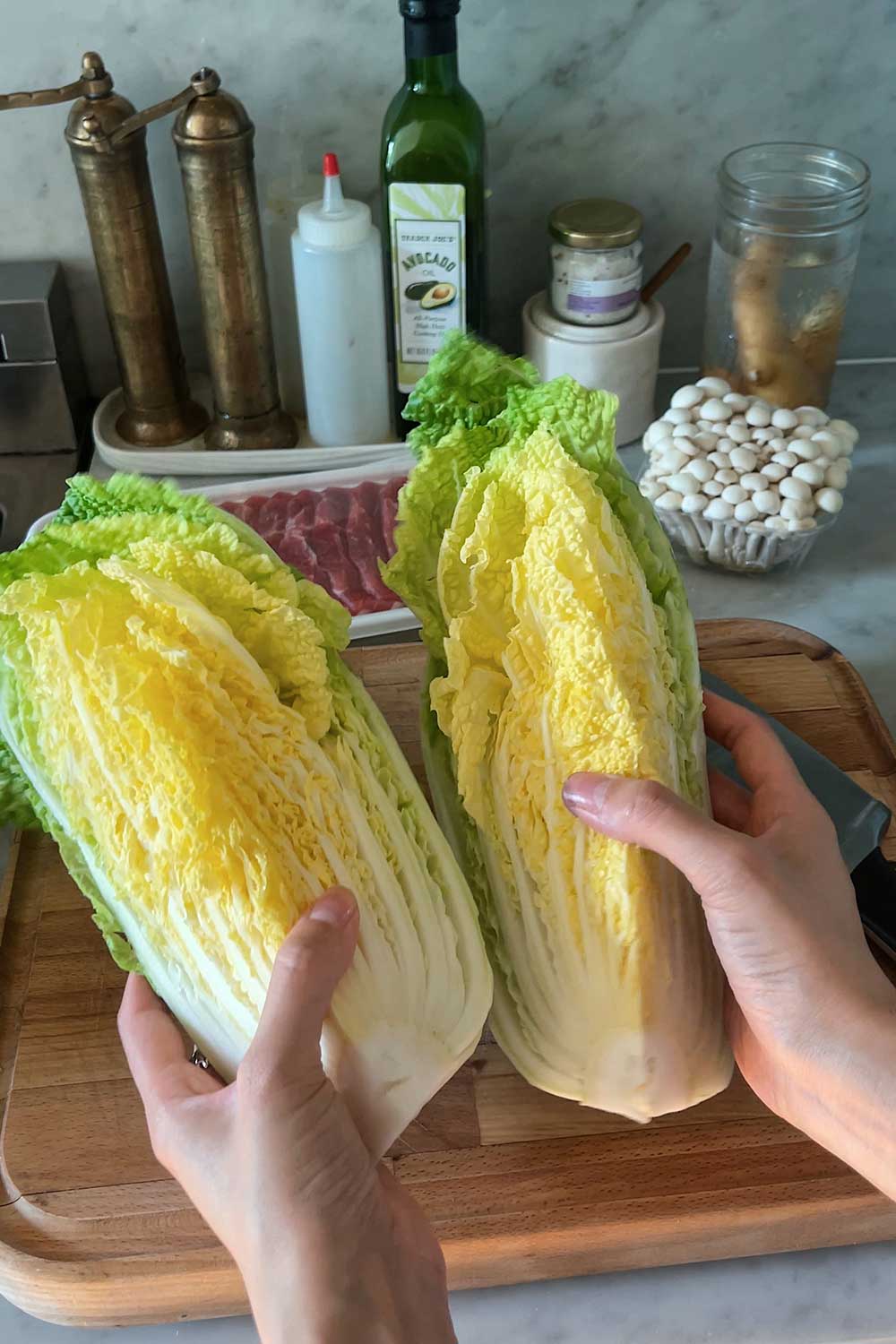
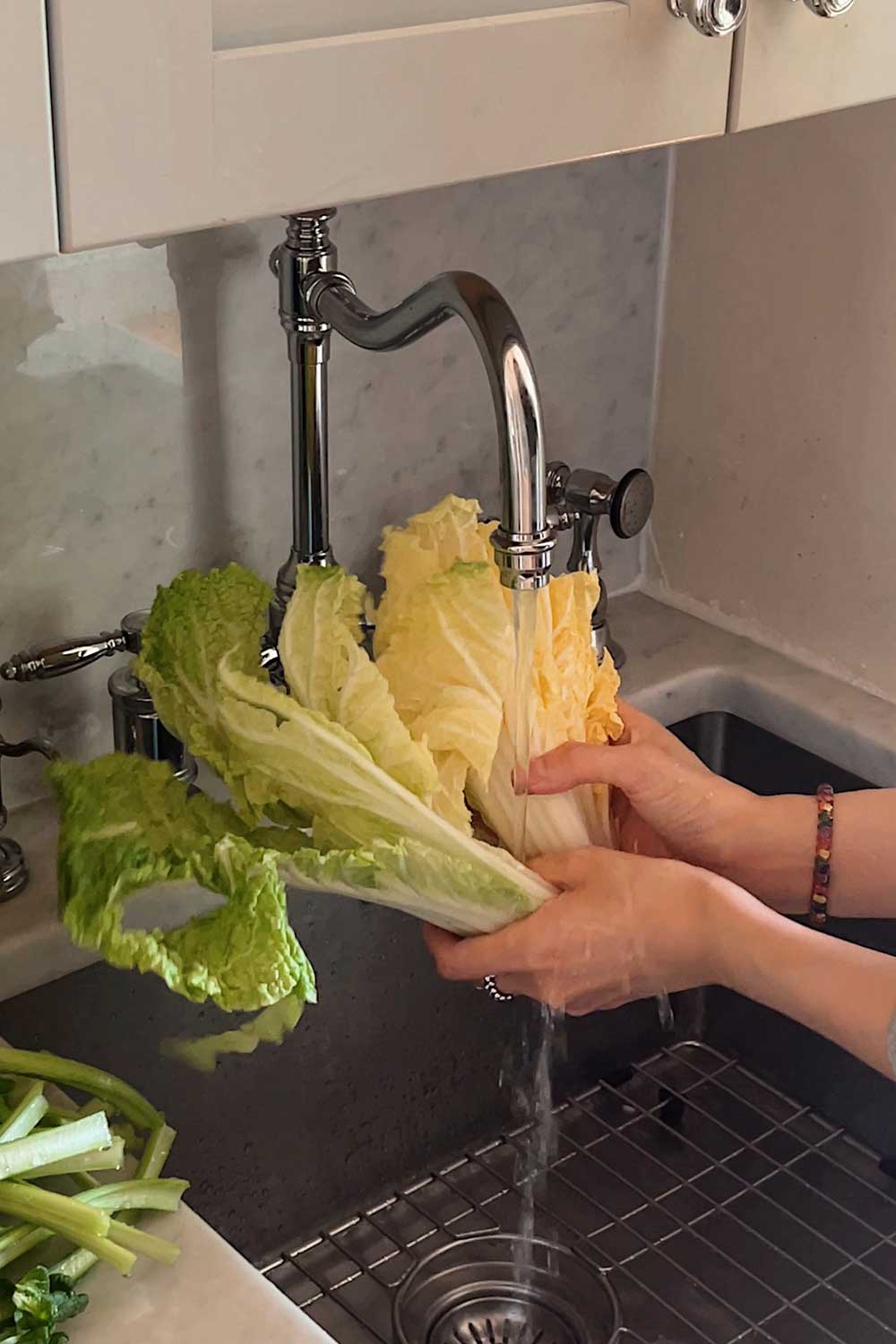
cut and washed napa cabbage
Tatsoi
I also added tatsoi from my indoor gardens.
Tatsoi is an Asian green similar to bok choy, but more spoon shaped. It has glossy round leaves and crunchy long stems.
Tatsoi can taste a bit bitter raw, so personally I always eat it cooked.
But it works well in soup form, since the sturdy leaves stand up well to hot broth.
I think it gives a nice color addition since cabbage leaves tend to be light green and yellow compared to the dark green of the tatsoi leaves.
You could also substitute with bok choy or chijimisai!
harvesting tatsoi I grew on my indoor garden
Thin Sliced Pork Belly
Traditional mille feuille nabe calls for pork belly.
Pork belly is salty, rich and fatty so it adds a nice savory element to the otherwise very light soup.
If you don’t like how fatty pork belly is, you can substitute with leaner cuts of meat, like beef brisket, rib-eye or chuck.
Just look for thin-sliced meat that’s cut ‘hotpot’ style, available at most grocery stores.
If you don’t have Asian grocery stores near you, try Weee!
They’re an online Asian grocery store and I find they have better pricing than most Asian markets in NYC.
assembling the layers
Assembling Mille Feuille Nabe
It can get a little messy to make the layers.
To make the process easier, I recommend keeping the base of the napa cabbage together as you’re assembling the layers (similar to how you keep an onion core together when chopping).
This keeps the stack neatly together.
Cut each section about 2″ tall, or to the height of your pot.
Start by placing the layers at the outer rim of the pot, and working your way in.
If you run out of layers, use the bits of cabbage and pork belly that fall off to pack the center. I also like adding mushrooms.
assembling the layers
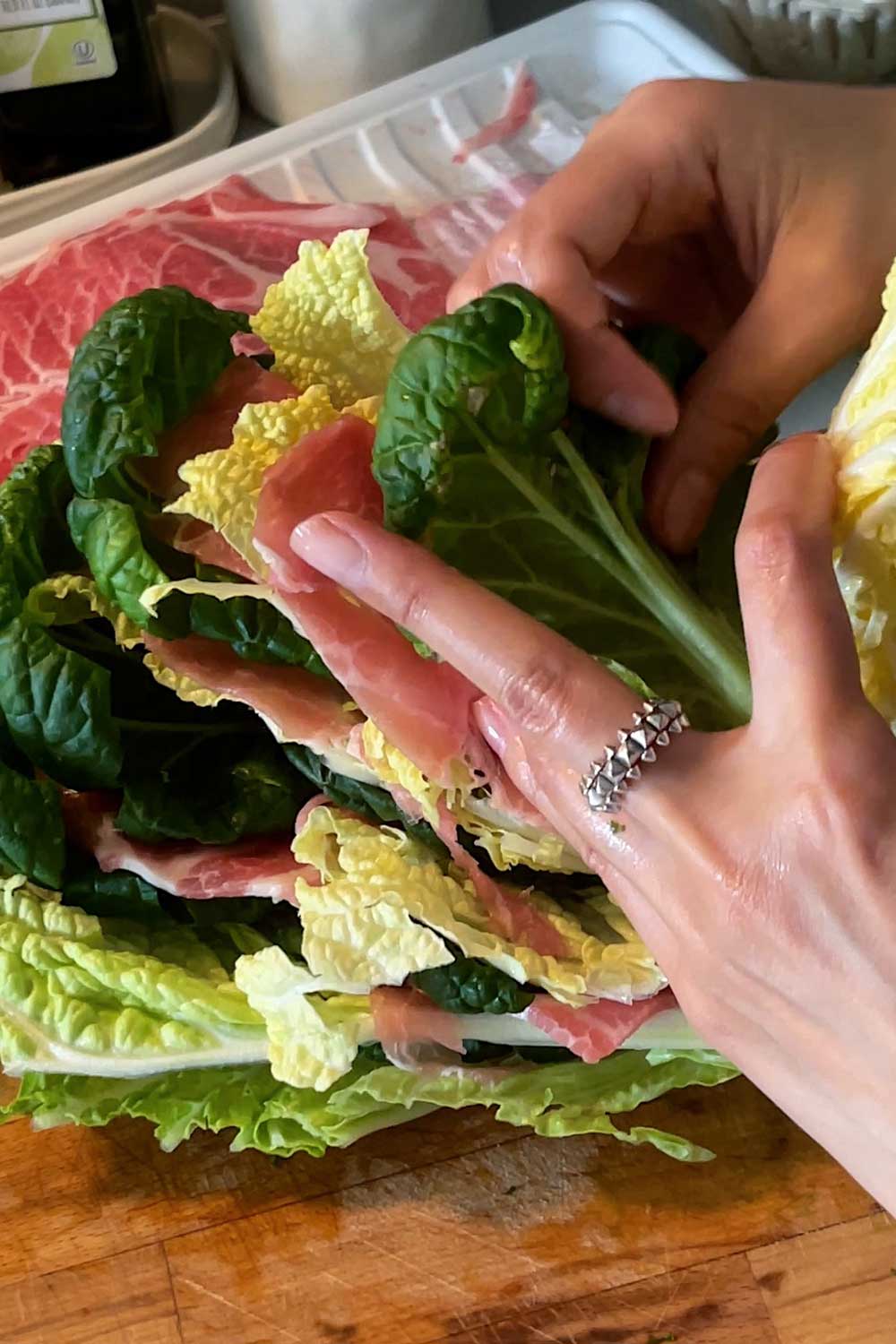
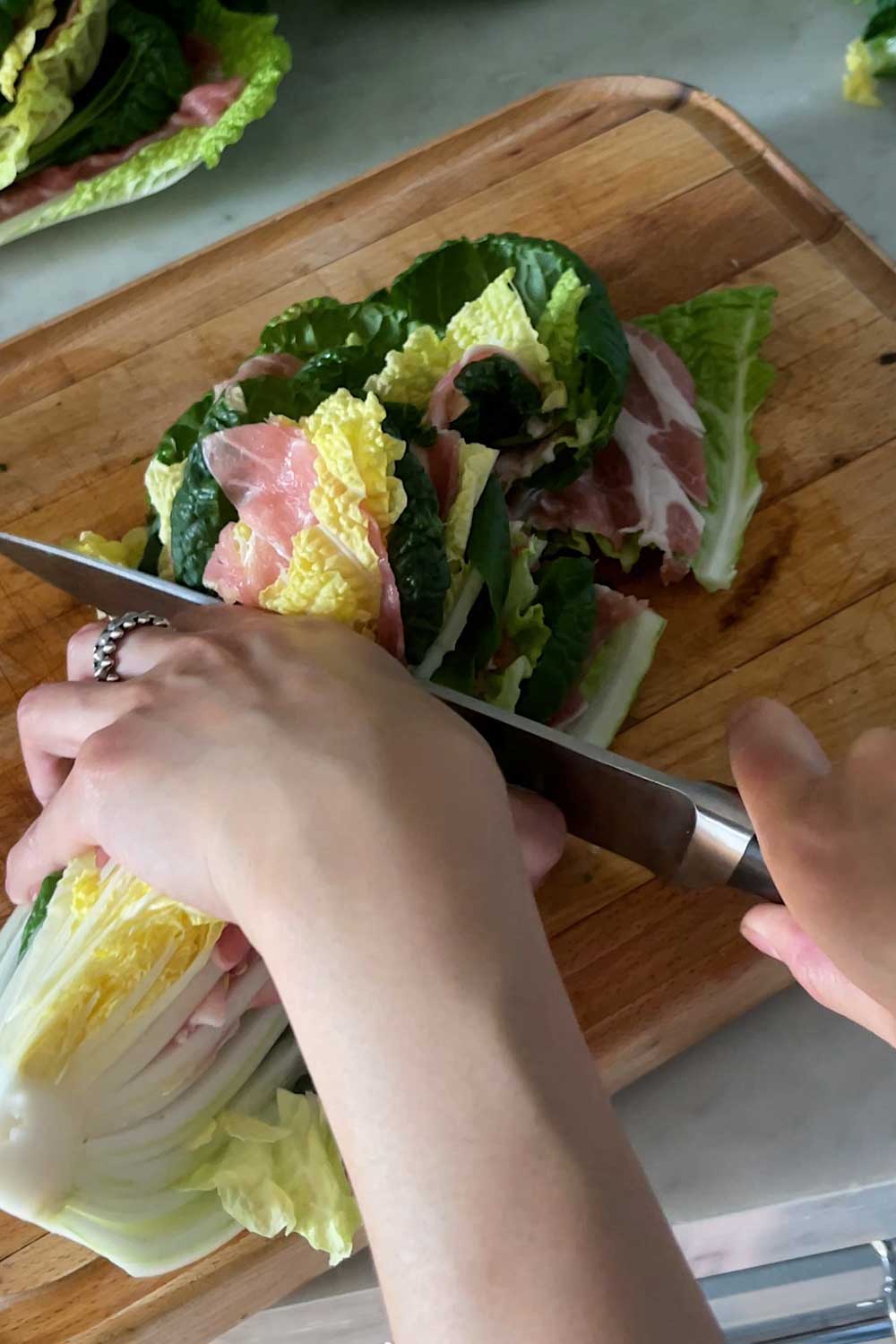

carefully cutting the assembled layers into ~2″ wedges
Dashi
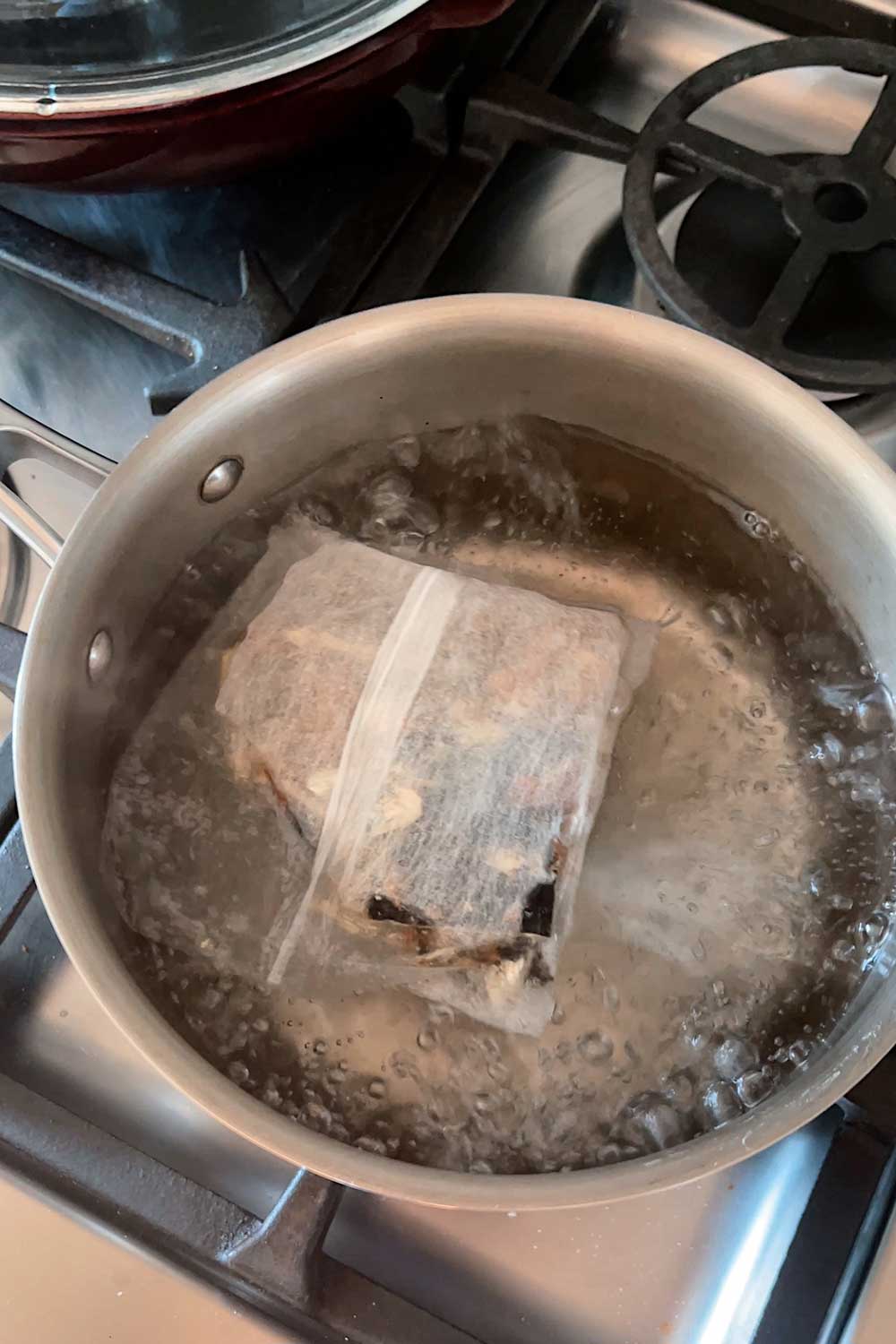
The layers are cooked in a light broth of Japanese dashi.
You can make this by using either powdered dashi or dashi packets.
I prefer the latter, because the ingredients are higher quality (the powdered jars often contain MSG and other additives).
If you’re in NYC, Dashi Okume in Greenpoint has really nice dashi satchets as well as a station where you can make your own dashi packets.
Dipping Sauce
The fun part of hot pot is always making your own bowl of dipping sauce!
Since mille feuille nabe is very light, you’ll want to pack a lot of flavor in the dipping sauce.
- For a classic approach, use Japanese ponzu with some thinly sliced green onion.
- For a slight kick, add a couple spoons of chili oil.
- For a nutty sauce, combine Chinese sesame paste, water, soy sauce, sesame oil, garlic and cilantro.
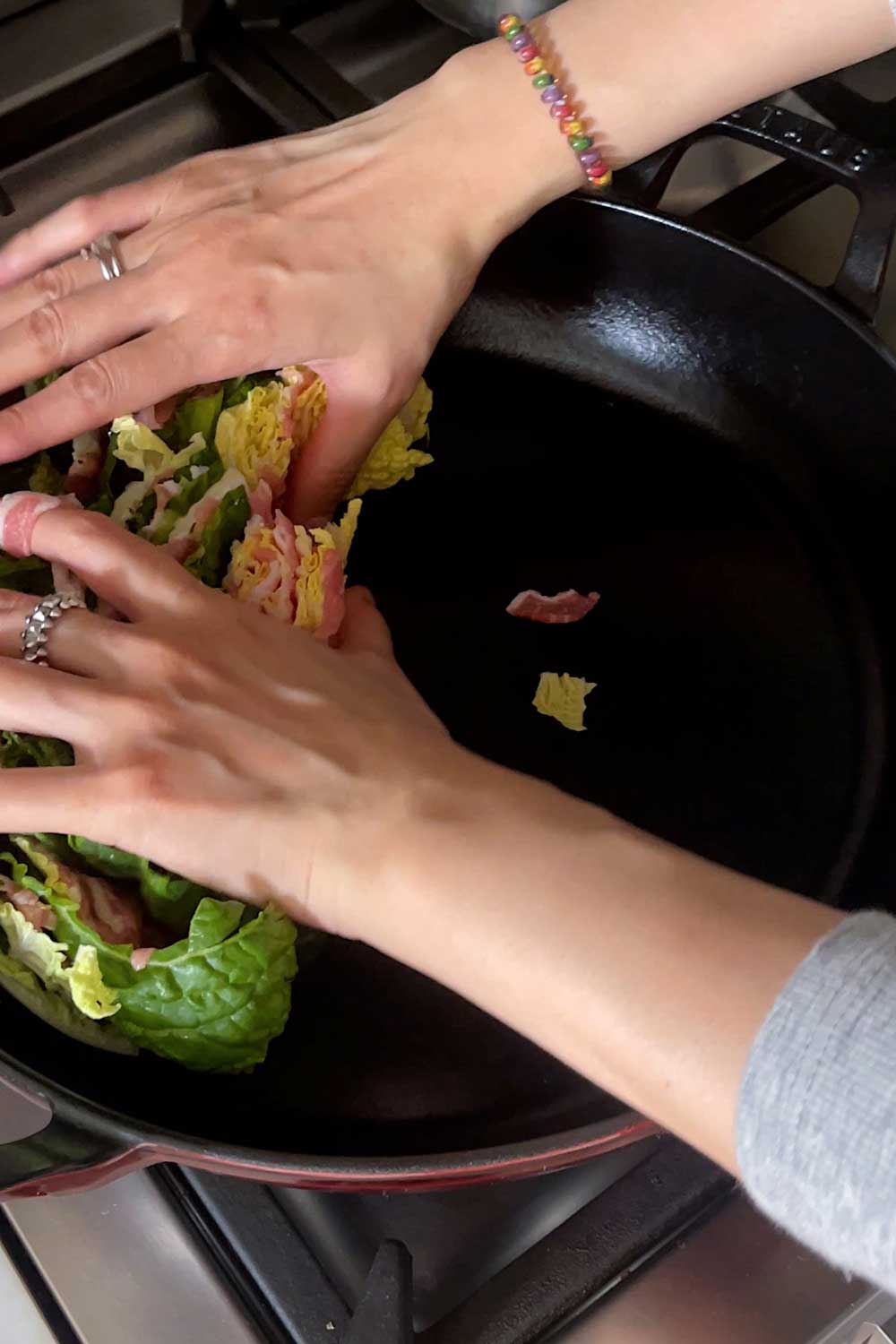
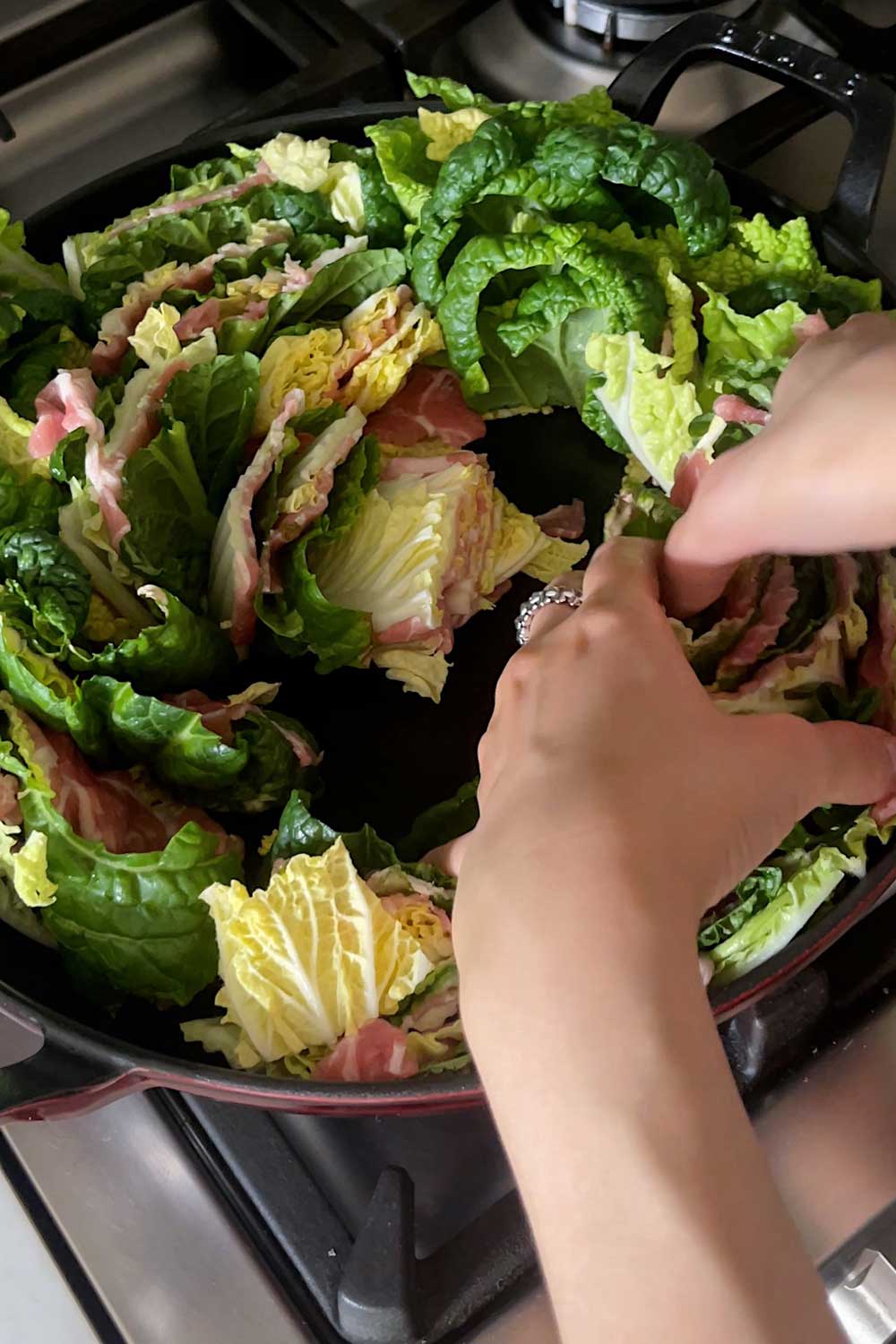
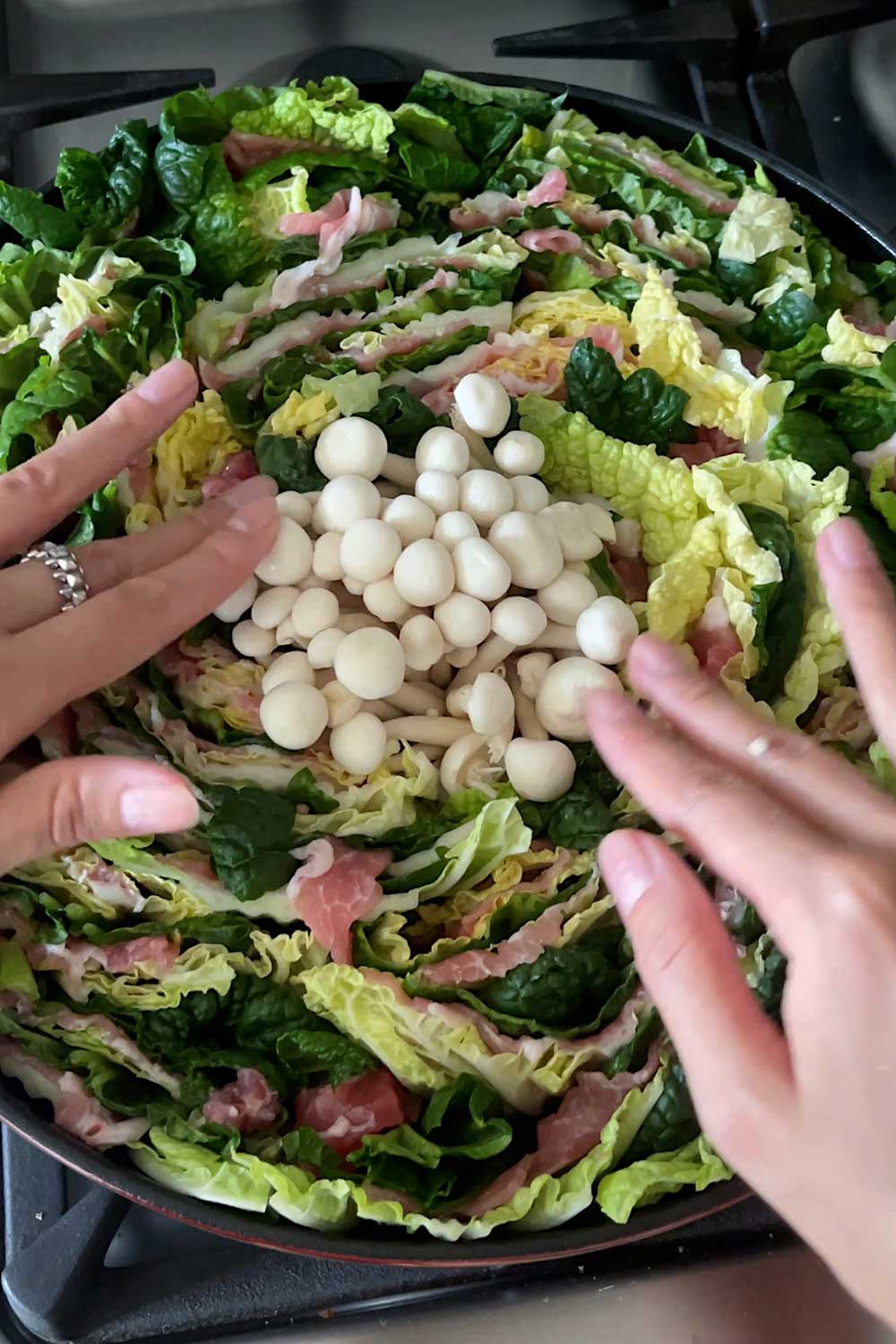
placing the wedges into the pot in a tight ‘rosette’ formation
Leftover Broth
Hotpot always ends with noodles!
There’s typically a lot of leftover soup in the pot once you finish all the cabbage and pork belly layers. It’s the perfect base to add some noodles!
I like chewy udon but you could use ramen, soba or even rice for your cozy carb finale.
you can cook nabe on the stove, or use a gas burner to cook it tableside
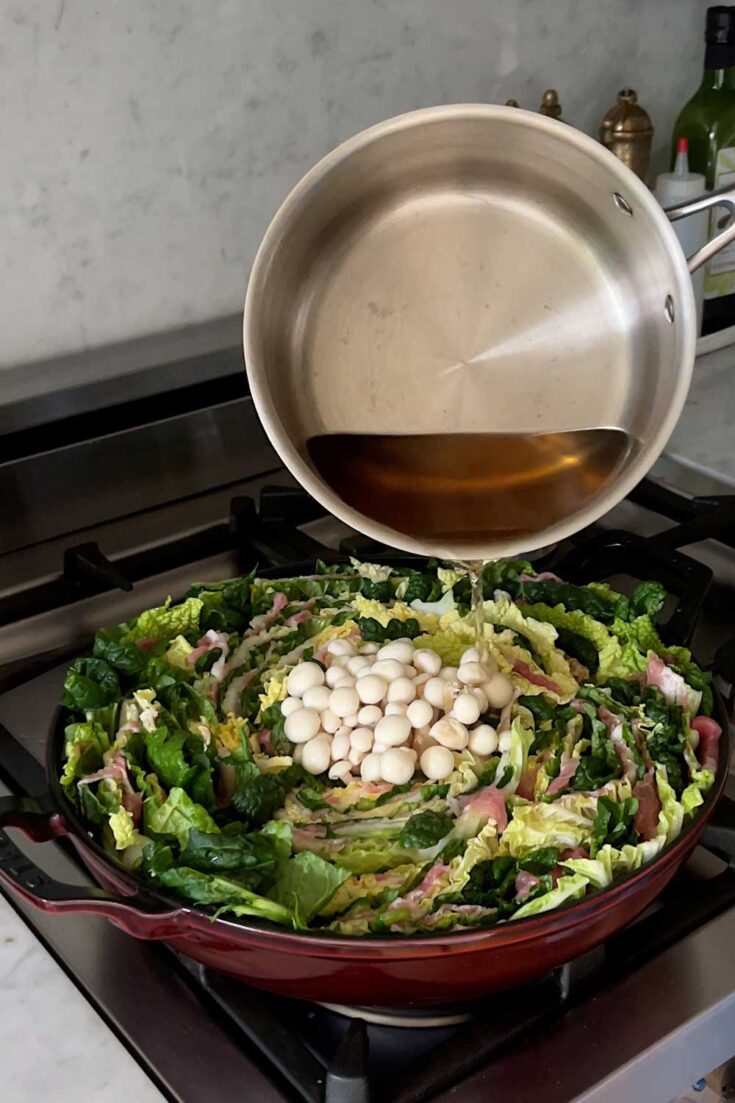
Mille Feuille Nabe
A light and simple hot pot meal at home!
Ingredients
For the Layers
- 1/2 head of Napa cabbage (~2 pounds)
- 1 pound thinly sliced pork belly
- 1 head of tatsoi (optional)
For the broth
- 5 cups dashi
- 1 knob of ginger
- 2 tbsp sake
- 1 tbsp soy sauce
- 1 tsp salt
For the dipping sauce
- ponzu
- scallion
- chili oil
Instructions
Make the Dashi
- In a small saucepan, add 5 cups of water and bring to a boil.
- Reduce the heat to low and drop in 2 dashi packets and the knob of ginger, simmer for 10 minutes.
- Turn off the heat, discard the dashi packets and ginger, and add sake, soy sauce and salt. Stir to combine then set aside.
Make the Dipping Sauce
- Thinly slice scallions and add to a small bowl.
- Pour in some ponzu and add some chili sauce (optional).
Assemble the Layers
- Cut a head of napa cabbage into quarters.
- Keeping the core intact, gently wash the layers of cabbage leaves. Make sure to drain and shake out as much water as possible. If any leaves naturally come off during this process, keep them to the side. They can be used to stuff any gaps in the dish during the assembling process.
- Form the layers by alternating a cabbage leaf with thinly sliced pork belly and tatsoi leaves.
- Try to adjust your pork belly layers to full cover the cabbage leaves by cutting or doubling up on pork belly, as needed.
- Once the layers are fully assembled, carefully cut into 2 inch wedges.
Mille Feuille Hotpot
- Add the wedges to your pot, starting from the outer rim and working your way to the center. Each stack should show a bit of green, pink and white to fully display all the layers.
- Continue packing the layers in a rosette-style shape. I suggest adding the thicker wedges (of the whiter cabbage base) towards the outside, leaving the more tender yellow leaf wedges for the center of the pot.
- At the center, place your mushrooms
- Make sure all the layers are tightly packed. If there are gaps, stick in the cabbage leaves that fell off during the washing and assembling process.
- Pour the dashi soup broth over the layers. Depending on the size of your pot, you may have leftover broth. I like to pour in less broth, as the soup will bubble up and spill over the stove if there's too much liquid.
- Turn the heat to medium high and bring the pot to a boil. Skim off any fat that foams to the surface.
- Reduce the heat to medium low, cover and cook for 8 to 10 minutes or until the cabbage leaves are soft and the pork has turned white.
- Serve with the dipping sauce and some rice!
Recommended Products
As an Amazon Associate and member of other affiliate programs, I earn from qualifying purchases.
Follow me on

